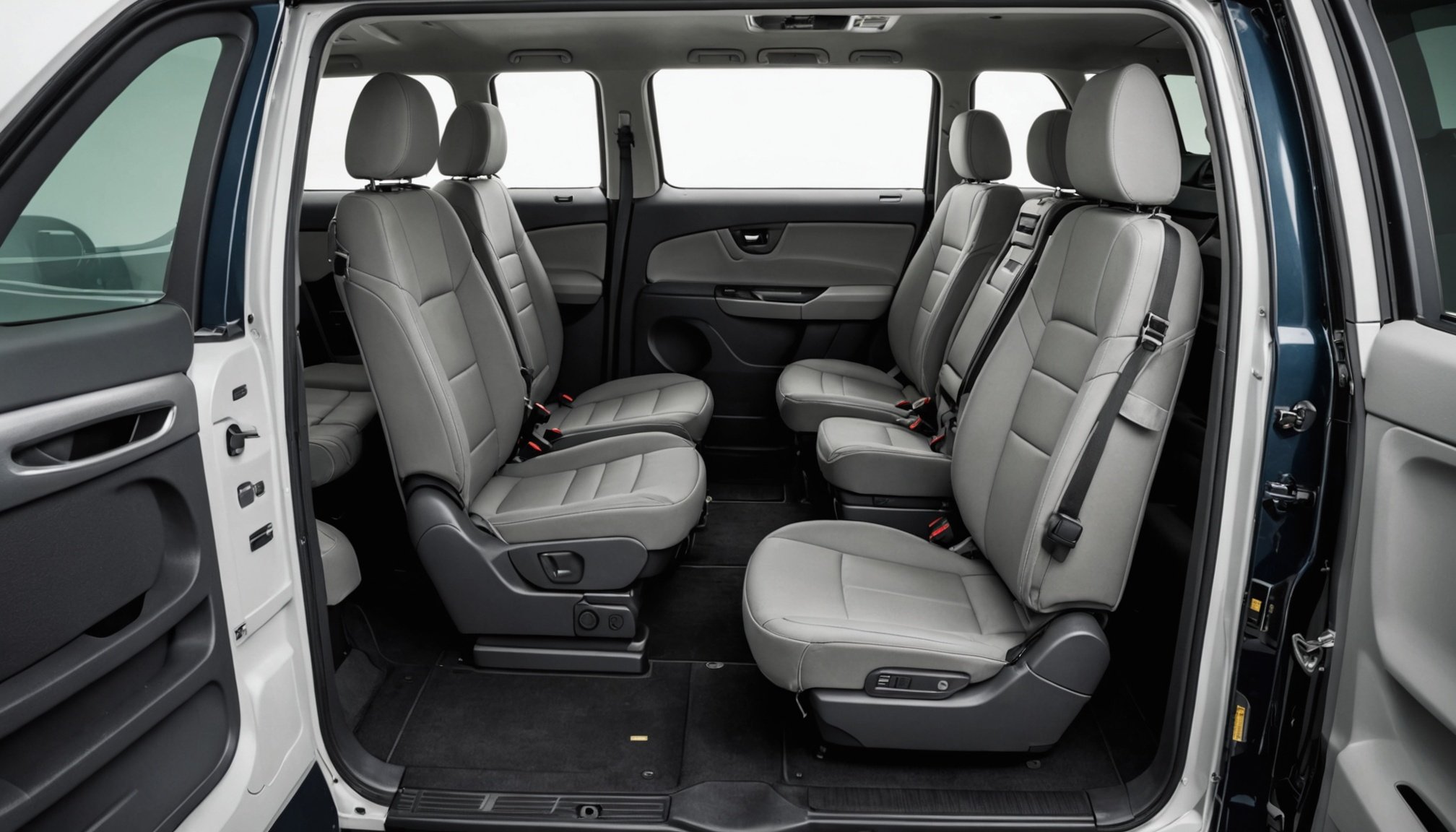Unlocking Airbag Sensitivity in Minivans: Key Strategies for Boosting Safety and Protection
When it comes to vehicle safety, few features are as critical as airbags. In minivans, which often carry multiple passengers, the effectiveness of airbags can be the difference between a minor incident and a catastrophic event. Here, we delve into the key strategies for enhancing airbag sensitivity and overall vehicle safety in minivans.
Understanding Airbag Technology
Airbags are a cornerstone of modern vehicle safety, designed to deploy in the event of a collision to cushion the impact and reduce the risk of injury or fatality. However, their effectiveness can vary based on several factors, including the type of airbag, the vehicle’s design, and the presence of other safety features.
In the same genre : Maximizing backup sensor performance in city driving: essential tips for smart drivers
Types of Airbags
Minivans typically come equipped with multiple types of airbags, each serving a specific purpose:
- Frontal Airbags: These are the most common type and deploy from the steering wheel and dashboard to protect the driver and passenger.
- Side Airbags: Located in the seats or doors, these airbags protect the torso and head in the event of a side impact.
- Curtain Airbags: These airbags drop down from the roof to protect occupants from head injuries in rollover crashes.
- Knee Airbags: Some vehicles include knee airbags to protect the lower extremities.
Enhancing Airbag Sensitivity
To boost the sensitivity and effectiveness of airbags, several strategies can be employed:
Also to see : Enhancing lane-keeping assist performance: tailoring vehicle configurations for optimal use on uk rural roads
Advanced Sensors and Algorithms
Modern vehicles, including minivans, are equipped with sophisticated sensors and algorithms that detect the severity and type of collision. These systems can adjust the deployment of airbags accordingly. For example, the 2025 Toyota Sienna features a pre-collision warning system with audible and visual warnings, which can also trigger automatic emergency braking if necessary[4].
- Advanced sensors to detect collision severity
- Algorithms to adjust airbag deployment
- Integration with other safety features like automatic emergency braking
Integration with Other Safety Features
Airbags are most effective when they work in conjunction with other safety features. For instance, electronic stability control (ESC) helps maintain vehicle stability, reducing the likelihood of a rollover or loss of control, which can trigger airbag deployment.
- Electronic Stability Control (ESC)
- Lane Keeping Assist
- Blind Spot Monitoring
- Rear Cross Path Detection
Regulatory Standards
The National Highway Traffic Safety Administration (NHTSA) sets strict standards for airbag performance through the Federal Motor Vehicle Safety Standards (FMVSS). Ensuring that minivans comply with these standards is crucial for maximizing airbag effectiveness.
| FMVSS Standard | Description |
|---|---|
| FMVSS 208 | Occupant Crash Protection |
| FMVSS 214 | Side Impact Protection |
| FMVSS 216 | Roof Crush Resistance |
Regular Maintenance
Proper maintenance is essential to ensure that airbags function correctly. This includes checking the airbag system for any faults or malfunctions, which can be indicated by the airbag warning light on the dashboard.
- Regular system checks
- Addressing any faults or malfunctions promptly
- Ensuring all occupants wear seat belts
The Role of Seat Belts and Seat Design
Seat belts are a fundamental component of vehicle safety and work in tandem with airbags to protect occupants.
Seat Belt Technology
Modern seat belts are designed with advanced features such as pretensioners and load limiters. Pretensioners tighten the belt in the event of a collision to reduce slack, while load limiters allow some belt movement to reduce the force on the occupant.
- Pretensioners to reduce belt slack
- Load limiters to manage force on occupants
- Adjustable and retractable belts for comfort and safety
Rear Seat Safety
Minivans often have multiple rear seats, and ensuring these seats are designed with safety in mind is critical. Features like the “Check Rear Seat” reminder in the 2023 Toyota Sienna help prevent children or pets from being left unattended in the rear seats[3].
Vehicle Stability and Control
Vehicle stability and control systems play a significant role in preventing accidents and ensuring airbags deploy only when necessary.
Electronic Stability Control
Electronic Stability Control (ESC) helps the vehicle stay on course by automatically adjusting engine power and applying the brakes to individual wheels. This reduces the risk of skidding or losing control, which can lead to airbag deployment.
- Automatic adjustments to engine power and braking
- Real-time monitoring of vehicle stability
- Integration with other safety features like lane departure warning
Throttle Control and Brake Assist
Features like throttle control and brake assist enhance the driver’s ability to control the vehicle. For example, Rain Brake Support in RAM trucks ensures the brake pads remain dry during wet conditions, maintaining optimal braking performance[1].
Future Advancements in Airbag Technology
As vehicle safety continues to evolve, so too does airbag technology. Here are some future advancements that promise to further enhance airbag sensitivity and overall vehicle safety:
Advanced Driver Assistance Systems (ADAS)
New ADAS technologies, such as blind spot intervention and lane keeping assist, are being integrated into vehicles to prevent accidents. These systems can also improve the timing and effectiveness of airbag deployment[2].
Semi-Autonomous Driving
Features like Active Driving Assist, which combines adaptive cruise control and lane centering, are on the horizon. These systems reduce the workload on drivers, ensuring they remain vigilant and in control, thereby enhancing safety[1].
Practical Insights and Actionable Advice
Here are some practical tips to ensure you get the most out of your minivan’s airbag system:
- Always Wear Seat Belts: Seat belts are the first line of defense in any collision. Ensure all occupants wear their seat belts correctly.
- Regular Maintenance: Check your vehicle’s airbag system regularly and address any issues promptly.
- Stay Informed: Keep up-to-date with the latest safety features and technologies available in new vehicles.
- Use Safety Features Wisely: Understand and use advanced safety features like lane departure warning and blind spot monitoring to prevent accidents.
Enhancing airbag sensitivity in minivans is a multifaceted approach that involves advanced sensors, integration with other safety features, compliance with regulatory standards, and regular maintenance. By understanding the latest technologies and best practices, you can significantly boost the safety and protection of your vehicle. Whether you’re navigating busy city streets or embarking on a long road trip, a well-maintained and technologically advanced minivan can provide peace of mind and ensure you arrive safely at your destination.
As a final thought, here’s what a safety expert might say:
“Airbags are a critical component of vehicle safety, but they are only as effective as the system they are part of. By combining advanced airbag technology with other safety features and maintaining your vehicle properly, you can create a safe and protective environment for all occupants.”











